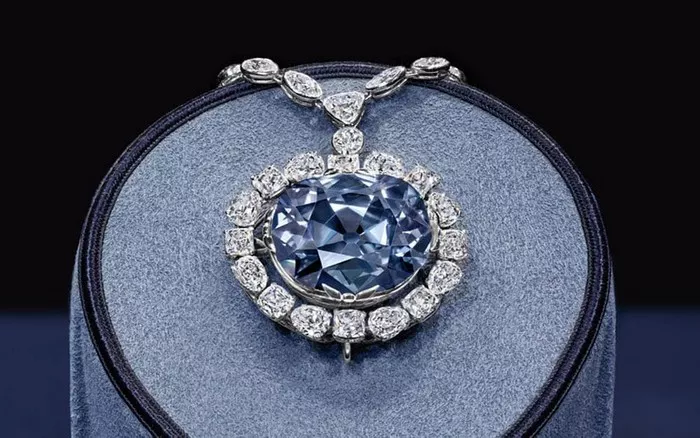In the realm of extraordinary gemstones, few hold as much allure and intrigue as the Hope Diamond Necklace. This exquisite piece of jewelry, with its deep blue hue and storied past, has captured the imagination of generations. From its mysterious origins to its journey through history, the Hope Diamond Necklace is not just a symbol of beauty but a testament to the enduring fascination with rare and precious gems.
The Genesis of the Hope Diamond
The story of the Hope Diamond Necklace begins centuries ago, in the mines of Golconda, India, where some of the world’s most magnificent diamonds were unearthed. It is believed that the Hope Diamond originated from these legendary mines, renowned for producing diamonds of exceptional quality and clarity.
The exact date of the diamond’s discovery remains shrouded in mystery, but historical records suggest that it may have been mined as early as the 17th century. Its initial incarnation was likely as a rough stone, weighing much more than its current 45.52 carats. Over time, through the hands of skilled gem cutters, the diamond was transformed into the breathtaking gemstone we know today.
A Tale of Intrigue and Legend
One of the most captivating aspects of the Hope Diamond Necklace is its association with a series of captivating legends and tales of misfortune. According to one popular myth, the diamond was stolen from the eye of a statue of the Hindu goddess Sita, in the sacred city of Golconda. This act of sacrilege, it is said, cursed the diamond, bringing calamity upon all who possessed it.
While such stories add to the allure of the Hope Diamond, the truth behind its tumultuous history is perhaps even more fascinating. The diamond’s first documented appearance in Europe was in the 17th century when it was acquired by the French merchant Jean-Baptiste Tavernier during his travels to India. Tavernier sold the diamond to King Louis XIV of France, who had it recut into a 67.125-carat stone known as the “French Blue.”
The French Connection
Under the patronage of King Louis XIV, the French Blue became one of the most famous jewels in Europe, adorning the royal crown of France. However, the diamond’s association with the French monarchy would prove to be short-lived. In 1792, during the French Revolution, the crown jewels, including the French Blue, were stolen from the royal palace and subsequently disappeared.
See Also: Can You Wear a Rose Quartz Necklace Every Day?
For decades, the fate of the French Blue remained a mystery until it resurfaced in London in the early 19th century, in the possession of a British diamond merchant named Daniel Eliason. The diamond had been recut and reduced in size, possibly to conceal its true identity. It was during this time that the stone acquired its new name, the “Hope Diamond,” after Henry Thomas Hope, a wealthy English banker who acquired the gem in 1839.
The Legacy of the Hope Diamond
The acquisition of the diamond by the Hope family marked the beginning of a new chapter in its storied history. Over the years, the diamond passed through several hands, each adding to its mystique and legend. However, it was not until the early 20th century that the Hope Diamond truly captured the world’s attention.
In 1910, the diamond was purchased by the American socialite Evalyn Walsh McLean, who had it set into a necklace surrounded by smaller white diamonds. McLean’s ownership of the diamond only served to fuel its reputation for bringing misfortune, as tragedy seemed to follow her wherever she went. Despite the supposed curse, McLean remained devoted to the diamond until her death in 1947.
Following McLean’s passing, the Hope Diamond passed into the hands of various private collectors before ultimately finding a permanent home at the Smithsonian Institution in Washington, D.C. Today, the Hope Diamond remains one of the most popular attractions at the Smithsonian’s National Museum of Natural History, where it continues to captivate visitors from around the world.
The Gemological Marvel
Beyond its rich history and legendary status, the Hope Diamond is also a remarkable feat of gemological craftsmanship. The diamond’s deep blue color, known as “fancy dark grayish-blue,” is incredibly rare and is believed to be the result of trace amounts of boron within the crystal structure.
In addition to its color, the Hope Diamond possesses several unique features that set it apart from other diamonds. Its large size, exceptional clarity, and distinctive clarity characteristics, including internal graining and a small “extra facet” on the pavilion, make it a truly exceptional gemstone.
Conclusion
The Hope Diamond Necklace is more than just a piece of jewelry; it is a symbol of human ingenuity, perseverance, and the enduring allure of rare and precious gems. From its mysterious origins in the mines of Golconda to its current resting place at the Smithsonian Institution, the diamond has captured the hearts and imaginations of countless individuals around the world.
Despite its association with tales of misfortune and tragedy, the Hope Diamond remains a source of wonder and fascination for gemologists, historians, and enthusiasts alike. Its rich history, legendary status, and unparalleled beauty ensure that the Hope Diamond Necklace will continue to captivate and inspire for generations to come.

